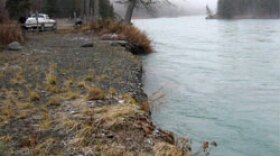Sockeye salmon are still pouring into the Russian river, but the real big fishery on the Kenai Peninsula will get started Wednesday.
The Kenai river personal use dipnet fishery opens at 6 a.m., but the fish aren’t exactly rushing in to meet dipnetters. So far, not quite 80,000 reds have been estimated up the river.
“The late-run sockeye are just starting to trickle in," says ADF&G sportfish area manager Colton Lipka. "Anglers are picking up a few from shore. But overall it is still slow. We have high water, dirty water in the Kenai right now which is causing fish to move around and be in some different places as they adjust to the different currents. But it is still early. We’ve got a little time before we’ll probably see any big pulses.”
The Kenai river is forecast to see approximately 3.8 million fish return, that’s a bit higher than the 20 year average. The inriver escapement goal is between 1 and 1.3 million. With temperature records being broken seemingly every day lately, anadromous waters are heating up, too. Lipka says that’s less of a concern on the Kenai or Kasilof, but could affect smaller streams.
“Water temperature can have a multitude of effects throughout all life stages of the fish. For these returning fish, there’s been a general trend where this warmer water tends to push things back a little later in run timing, but it’s still all variable. We don’t know all that until they return. Mostly with this warmer water and warmer temperatures, we probably want anglers to focus more on their fish care; as these fish are coming out of the water, to keep from spoilage, taking extra care to get the fish in the coolers, get them on ice or keep them on stringers in the river.”
Late-run king salmon are also slow to return through the turbid waters of the Kenai. As of Monday, just over 1,200 chinook had been counted. On the Kasilof, where dipnetting and subsistence setnetting has been underway for a couple weeks, about 100,000 reds have made it past the sonar counters.



